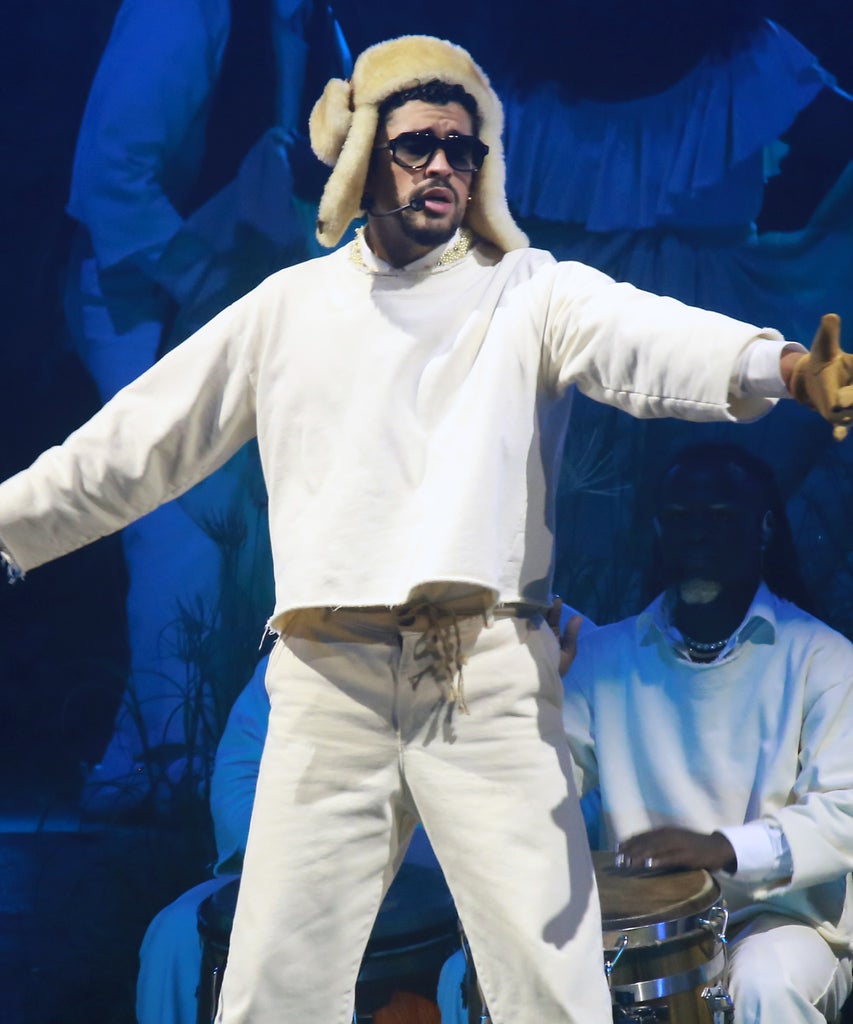
Since the NFL broke the news on Sunday night that Bad Bunny will be the 2026 Apple Music Super Bowl halftime show performer, the MAGA-verse has been inflamed — and that’s kind of the point.
When Bad Bunny, born Benito Antonio Martínez Ocasio, takes the stage on February 8 at Levi’s Stadium in Santa Clara, California, he’ll be crashing the biggest old boys’ club in America as everything the ultra-conservative loves to hate: a Latine who refuses to perform in English, critiques the Trump administration, defies gender roles, advocates for immigrant and queer communities, and calls for the decolonization of Puerto Rico — and he does it all with global reach, power, and support.
While the Latin trap and reggaeton artist-actor recently told Apple Music that he is still “figuring out” what he’s going to do during his performance, the political right have already begun lashing out at the artist.
“While the Latin trap and reggaeton artist-actor recently told Apple Music that he is still ‘figuring out’ what he’s going to do during his performance, the political right have already begun lashing out at the artist.”
Raquel reichard
Conservative podcaster Benny Johnson called Bad Bunny a “massive Trump hater” and “anti-ICE.” Newsmax host Greg Kelly claimed the artist “hates America” and “hates the English language.” And Ryan Fournier, chair of Students for Trump, suggested that executives at Roc Nation — the entertainment agency founded by Jay-Z, which has partnered with the NFL on halftime show production since 2019 — “should be fired.”
But the vitriolic attacks and reemerging calls to boycott the Super Bowl come as no surprise. Since Roc Nation began collaborating with the league — part of the NFL’s broader effort to repair its image and address longstanding racial and social justice concerns following the Colin Kaepernick protests against police violence — every non-white artist who has taken the coveted halftime spot has faced backlash from conservative critics accusing the NFL of pushing a “woke” agenda or prioritizing diversity, equity, and inclusion (DEI) over talent. Nevermind that to qualify for the biggest stage in the world, artists must be among the biggest in the world — and whether critics like it or not, performers like Beyoncé, Kendrick Lamar, Usher, Rihanna, Jennifer Lopez, Shakira, and now Bad Bunny are chart-toppers and global icons.
Unlike Jason Aldean — whom Texas Attorney General Ken Paxton suggested as a more “patriotic” choice — these artists dominate streaming platforms, regularly top Billboard charts, and have massive international followings. Bad Bunny, for instance, was Spotify’s most-streamed artist globally in 2020, 2021, and 2022, surpassing both Taylor Swift and Drake. On the Billboard 200, he has achieved multiple No. 1 albums, including El Último Tour del Mundo (2020), Un Verano Sin Ti (2022), Nadie Sabe Lo Que Va a Pasar Mañana (2023), and Debí Tirar Más Fotos (2025). The finale of his recent No Me Quiero Ir de Aquí residency in Puerto Rico, itself a historic moment for him and his island, was streamed globally on Amazon Music, Prime Video, and Twitch, and it became the most-watched single-artist livestream in Amazon Music’s history.
If Bad Bunny does use his Super Bowl performance as a political platform, he won’t be the first. Many of Bad Bunny’s predecessors have used the roughly 12- to 15-minute halftime show — which is watched by more than 100 million viewers worldwide — as an opportunity to speak out against injustice. In 2016, Beyoncé incorporated powerful imagery highlighting Black Lives Matter and police brutality. In 2020, Jennifer Lopez wore a Puerto Rican flag cape and spotlighted children in cages to protest immigration policies. That same year, Shakira infused her performance with Middle Eastern-inspired tongue-trilling, paying homage to her Lebanese heritage. In 2025, Kendrick Lamar and his collaborators delivered a politically charged show addressing systemic racism and social inequity, with Lamar famously proclaiming, “the revolution will be televised,” all while President Donald Trump sat in the audience.
“If Bad Bunny does use his Super Bowl performance as a political platform, he won’t be the first.”
Raquel reichard
And yet Bad Bunny is arguably the most overtly political artist booked for the halftime spot. Martínez Ocasio has consistently used his music to speak out on a range of political and social issues, particularly those affecting Puerto Rico and other marginalized communities. His 2018 hit “Estamos Bien” became an anthem of resilience in the wake of Hurricane María, subtly addressing the U.S. government’s neglect of Puerto Rico during the crisis. In 2019, he released “Afilando los Cuchillos” alongside Residente and iLe, a diss track aimed at then-Governor of Puerto Rico Ricardo Rosselló after the leak of offensive Telegram chats. The song quickly became the unofficial soundtrack of the mass protests that ousted Rosselló, and Bad Bunny even paused his European tour to join demonstrators in the streets of Viejo San Juan. In 2020, amid the George Floyd protests and the global rise of the Black Lives Matter movement, he released “Compositor del Año,” a spoken-word piece that condemned anti-Black police violence and U.S. racial hypocrisy, stating: “A Black man with a gun is a criminal, but if he’s white, it’s a hobby.”
His 2022 blockbuster album Un Verano Sin Ti deepened his political commentary. The track “El Apagón” criticized power outages, displacement, and gentrification on the archipelago, specifically calling out the privatization of Puerto Rico’s electrical grid and the influx of wealthy foreign investors. On the same album, “Andrea (Feat. Buscabulla)” told the story of a young woman navigating systemic gender violence in Puerto Rico, widely seen as a tribute to Andrea Ruiz Costas, a femicide victim failed by the justice system. And his latest project, DeBÍ TiRAR MáS FOToS, was in many ways a call for a decolonized Puerto Rico. Songs like “Lo Que le Pasó a Hawái” warned Puerto Ricans of cultural erasure and economic displacement, drawing parallels between the island and tourist-saturated Hawai‘i. The album also incorporated ancestral Afro-Puerto Rican rhythms and jíbaro sounds, grounding its critique in the cultural and musical roots of the island’s working class.
Unlike Latine stars before him, Bad Bunny has made it a point not to make music in English. But it’s not because he hates the language; it’s because it’s not his language. He’s said that just as he grew up consuming English-language pop without fully understanding it, English-speaking audiences can do the same with Spanish. “I am never going to [sing in English] just because someone says I need to do it to reach a certain audience,” he told People in 2023. “It’s just that I feel more comfortable in my own language. I think in Spanish, I feel in Spanish, I eat in Spanish, I sing in Spanish.”
“And yet Bad Bunny is arguably the most overtly political artist booked for the halftime spot.”
raquel reichard
And he’s not alone. Despite Trump’s executive order making English the official language of the U.S., more than 43 million people in the country speak Spanish at home. It is the second-most spoken language in the U.S., and the U.S. is the second-largest Spanish-speaking country in the world, after Mexico. “This halftime show is a confirmation that Spanish is not just a ‘foreign’ language here, but rather a real-life example of how Spanish is woven into the fabric of American life,” Esteban Touma, a Spanish teacher, linguist, and cultural expert at Babbel, told Refinery29 Somos. “Bad Bunny’s art showcases that Spanish speaking has a place in the U.S. cultural zeitgeist. In fact, this halftime show pushes back on the idea that speaking Spanish is un-American. Let’s not forget that Puerto Rico is part of the U.S.”
And as a colony of the U.S. for 127 years, Puerto Rico’s Spanish dialect has been shaped by its complex history, migration patterns, and the creativity of its speakers. This Caribbean Spanish is sometimes viewed by other Latin American communities as “sloppy” or “ghetto.” And yet, it is precisely this vibrant dialect that Bad Bunny will proudly showcase to a global audience. According to Touma, “it showcases the possibility of a multi-cultural community.”
“Bad Bunny will be on the world’s biggest stage, proudly speaking Spanish in his native dialect, flipping any stigma on its head,” Touma said. “For Spanish speakers and Puerto Ricans specifically, my hope is that this performance is deeply validating.”
“Unlike Latine stars before him, Bad Bunny has made it a point not to make music in English. But it’s not because he hates the language; it’s because it’s not his language.”
raquel reichard
And it already has been. Even for Latines who aren’t necessarily Bad Bunny or reggaeton fans, the artist commands respect. Even more so after he told i-D Magazine in September that he left the U.S. off his recent tour dates due to concerns about Immigration and Customs Enforcement (ICE) raids at concert venues. “It’s something that we were talking about and very concerned about,” he said in the interview. While some critics pointed out the apparent contradiction between skipping a U.S. tour and performing at the Super Bowl, the two situations aren’t the same. A one-night, tightly controlled event like the Super Bowl carries far fewer risks than a multi-city tour, where ICE activity can vary widely by location. And unlike the crowds at his concerts, the Super Bowl audience is mostly corporate guests and NFL insiders — not the fans he was concerned about protecting.
Bad Bunny has publicly taken aim at Trump’s policies, rhetoric, and camp before, first following his inaction in Puerto Rico after Hurricane María and, more recently, in 2024, after Trump-supporting comedian Tony Hinchcliffe called Puerto Rico a “floating island of garbage” at a rally. After saying the joke “wasn’t funny,” he endorsed Kamala Harris for president — a rare move meant to mobilize his U.S.-based fanbase, since as a Puerto Rican resident, he himself cannot vote in U.S. presidential elections.
While Bad Bunny hasn’t said how — or even if — he’ll use his Super Bowl halftime show to send a political message, it already is political.
“In February 2026, he’ll carry that flag, that history, and that ancestral rebellion to the 50-yard line.”
RAQUEL REICHARD
His refusal to tour the U.S. — walking away from the millions he would’ve earned from what would undoubtedly have been another sold-out stadium run — was an act of protest. And so is accepting the halftime stage, where he won’t be paid, in order to bring reggaeton — a genre born from protest and Afro-Caribbean resistance — and his decolonial Puerto Rican message to the most-watched stage in the U.S. and the heart of its colonizer. A stage where, at this moment, he may have more enemies than fans in the crowd.
There is one thing we do know about his vision for the show, though. Bad Bunny said it’s “for those who came before me and ran countless yards so I could come in and score a touchdown… this is for my people, my culture, and our history.”
And it’s exactly that decentering of white America during white America’s favorite pastime that has so many on the right up in arms.
But as Bad Bunny raps in “LA MuDANZA,” “Aquí mataron gente por sacar la bandera. Por eso es que ahora yo la llevo donde quiera. (“Here, they killed people for raising the flag. That’s why now I carry it everywhere),” and in February 2026, he’ll carry that flag, that history, and that ancestral rebellion to the 50-yard line.
Like what you see? How about some more R29 goodness, right here?






